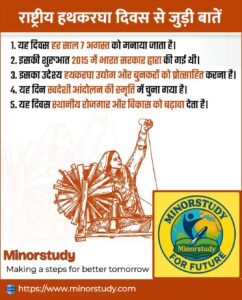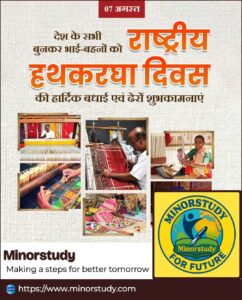National Handloom Day – A Tribute to India’s Timeless Weaving Legacy
The handloom sector is not just a part of India’s economy; it is a living testimony to our country’s cultural diversity, skill, and artistry. National Handloom Day, observed annually on 7th August, is a celebration of this very spirit. It honours the contribution of handloom weavers, promotes the pride of indigenous weaving traditions, and inspires the younger generation to cherish and support this heritage.
- History of National Handloom Day
- Timeline of Key Events
- Interesting Facts about National Handloom Day
- Significance of National Handloom Day
- How National Handloom Day is Observed
- Wishing Messages for National Handloom Day
- Importance in Our Life and Society
- FAQs on National Handloom Day
- Conclusion – Daily Life Impacts of National Handloom Day
History of National Handloom Day
The first National Handloom Day was celebrated on 7th August 2015 by the Government of India. The date was chosen for a special reason—it marks the launch of the Swadeshi Movement in 1905, when Indians took a pledge to boycott foreign goods and promote local products, especially handwoven textiles.
The inaugural event in 2015 was launched by Prime Minister Narendra Modi in Chennai, Tamil Nadu.
The aim was to recognise the handloom sector’s contribution to the socio-economic development of the country.
Since then, the day has become a platform to showcase traditional weaves like Khadi, Ikat, Pochampally, Banarasi, Kanchipuram, and more.

Timeline of Key Events
| Year | Event |
|---|---|
| 1905 | Swadeshi Movement launched on 7th August to promote indigenous goods. |
| 2015 | First National Handloom Day celebrated in Chennai. |
| 2016 | Campaigns like “My Handloom My Pride” introduced. |
| 2019 | Government launched “India Handloom Brand” initiative for quality certification. |
| 2020 | Amid COVID-19, virtual exhibitions held to support weavers. |
| 2022 | Theme – “Handloom, the pride of India” celebrated nationwide. |
| 2024 | Special digital marketplace for handloom products launched by Ministry of Textiles. |
Interesting Facts about National Handloom Day
India is the largest handloom producer in the world, with over 43 lakh people engaged in the sector.
Khadi became the symbol of India’s independence movement, popularised by Mahatma Gandhi.
Every state in India has its signature weave—like Assam’s Muga silk, Odisha’s Ikat, and Tamil Nadu’s Kanchipuram.
Handloom production is eco-friendly, requiring minimal electricity and having a low carbon footprint.
Women form 70% of the workforce in India’s handloom industry.
The sector has a history of over 2,000 years, dating back to the Indus Valley Civilization.
Many handloom products are GI (Geographical Indication) tagged, protecting their authenticity.
Significance of National Handloom Day
National Handloom Day carries multi-dimensional importance:
Cultural Significance – It safeguards India’s weaving traditions, ensuring they are passed down generations.
Economic Significance – It boosts rural employment and supports millions of households dependent on weaving.
Environmental Significance – Promotes sustainable fashion and reduces reliance on synthetic fabrics.
Social Significance – Empowers women by providing them livelihood opportunities close to home.
It also reminds us of the Swadeshi spirit, encouraging people to “buy Indian, wear Indian, and support Indian.”
How National Handloom Day is Observed
Exhibitions and Fairs – Handloom expos are organised across the country to showcase state-wise weaves.
Workshops and Training – Skill-development programs are conducted for young artisans.
Digital Campaigns – Hashtags like #MyHandloomMyPride trend on social media.
Government Announcements – Schemes to modernise looms, provide raw material subsidies, and improve market access.
School and College Activities – Awareness programs to inspire youth towards sustainable clothing choices.
Wishing Messages for National Handloom Day
🌸 “Let’s weave dreams of progress with the threads of tradition. Happy National Handloom Day!”
🧵 “Support our artisans, wear handloom, and carry India’s pride with you.”
🌿 “Handloom is not just fabric; it’s a story of love, skill, and heritage. Wishing you a Happy National Handloom Day!”
✨ “Every weave has a history. Every thread has a tale. Let’s preserve them.”

Importance in Our Life and Society
Cultural Identity – Wearing handloom connects us to our roots.
Sustainable Lifestyle – Choosing handloom over fast fashion helps the environment.
Economic Development – Each purchase supports local artisans and rural families.
Global Recognition – Indian handlooms are admired worldwide for their quality and craftsmanship.
Heritage Preservation – Handloom weaving is an art that keeps our ancient skills alive.
FAQs on National Handloom Day
Q1. Why is National Handloom Day celebrated on 7th August?
Because it marks the anniversary of the Swadeshi Movement’s launch in 1905.
Q2. Which Indian city hosted the first National Handloom Day?
Chennai, Tamil Nadu.
Q3. How can we support handloom weavers?
By buying handloom products directly from artisans, visiting exhibitions, and promoting them online.
Q4. What is the difference between handloom and power loom?
Handloom products are manually woven without electricity, while power looms are machine-operated.
Q5. Is handloom eco-friendly?
Yes, handloom weaving uses minimal resources and produces less pollution.
Conclusion – Daily Life Impacts of National Handloom Day
National Handloom Day is more than a symbolic date—it’s a call to action for every Indian. Every time we choose handloom, we empower an artisan, preserve an art form, and protect our planet. The day reminds us that our culture isn’t something we simply inherit—it’s something we must actively protect and promote.
In a world rushing towards mass production, handloom stands as a gentle reminder of patience, craftsmanship, and authenticity. Wearing handloom isn’t just a style choice—it’s a statement of pride.









Outfitting a second bike? Instead of overthinking, tour rockbros for the everyday bits—bags, pumps, storage—that make a ride simple again.
Great write-up, I?¦m regular visitor of one?¦s web site, maintain up the excellent operate, and It is going to be a regular visitor for a lengthy time.
кракен vk4
kraken marketplace